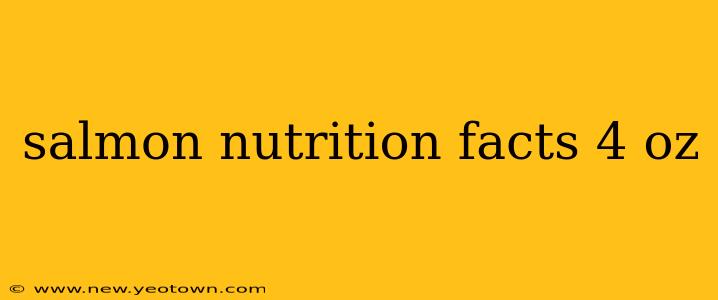Salmon. The word itself conjures images of glistening pink fillets, smoky grills, and a rich, buttery flavor. But beyond its culinary appeal, salmon is a nutritional powerhouse, packed with benefits that extend far beyond a delicious meal. Let's dive into the nutritional details of a typical 4-ounce serving, exploring what makes this fish so exceptional.
Imagine this: you're preparing a healthy dinner, and a perfectly cooked 4-ounce salmon fillet is the star of the show. It's a satisfying portion, offering a wealth of nutrients to fuel your body and mind. But exactly what are you getting?
A Typical Nutritional Breakdown of 4 Ounces of Cooked Salmon:
While exact values can vary based on the type of salmon, cooking method, and farming practices, a general guideline for a 4-ounce serving offers approximately:
- Calories: Around 200-250
- Protein: Approximately 25-30 grams – a significant source of high-quality protein essential for building and repairing tissues.
- Fat: Around 10-15 grams, predominantly healthy unsaturated fats, including omega-3 fatty acids. This is where salmon truly shines.
- Omega-3 Fatty Acids: These are the superstars of salmon nutrition. A 4-ounce serving provides a substantial amount of EPA and DHA, crucial for heart health, brain function, and reducing inflammation.
- Vitamin D: Salmon is an excellent source of vitamin D, vital for bone health, immune function, and mood regulation.
- Selenium: A powerful antioxidant that protects cells from damage.
- Vitamin B12: Essential for nerve function and red blood cell formation.
- Potassium: Supports healthy blood pressure.
- Niacin (Vitamin B3): Contributes to energy metabolism.
Frequently Asked Questions (FAQs) about Salmon Nutrition
Here, we'll address some common questions surrounding salmon nutrition, specifically focusing on a 4-ounce serving.
How many calories are in 4 ounces of cooked salmon?
As mentioned above, a 4-ounce serving of cooked salmon typically contains between 200 and 250 calories. This calorie count can fluctuate depending on the cooking method (baked salmon will generally have fewer calories than pan-fried). Remember that this is a relatively low-calorie source of protein and healthy fats, making it a great choice for weight management.
What are the benefits of eating salmon?
The benefits of incorporating salmon into your diet are numerous and far-reaching. The high levels of omega-3 fatty acids are particularly beneficial for:
- Heart Health: Omega-3s help reduce triglycerides, blood pressure, and the risk of blood clots, all contributing to a healthier cardiovascular system.
- Brain Health: These essential fatty acids are crucial for brain function, potentially reducing the risk of cognitive decline and Alzheimer's disease.
- Reduced Inflammation: Omega-3s have potent anti-inflammatory properties, beneficial for various health conditions.
- Improved Eye Health: They support eye health and may reduce the risk of age-related macular degeneration.
Is 4 ounces of salmon enough protein for a meal?
Yes, 4 ounces of salmon provides a significant amount of protein – approximately 25-30 grams. This is a substantial contribution to your daily protein needs, making it an excellent choice for building and maintaining muscle mass. Whether it’s sufficient for your individual needs depends on your overall dietary requirements and activity level.
What type of salmon is the healthiest?
While all types of salmon offer nutritional benefits, wild-caught salmon is often considered slightly healthier due to its higher omega-3 content and lower levels of pollutants compared to some farmed salmon. However, responsibly farmed salmon can also be a nutritious choice. Look for sustainably sourced salmon whenever possible.
Can I eat salmon every day?
While salmon is highly nutritious, it's generally recommended to incorporate it into a varied diet rather than consuming it daily. Moderation is key for maintaining a balanced nutritional intake and avoiding potential overconsumption of certain nutrients. Your body needs a variety of foods for optimal health.
How should I cook salmon to maximize its nutritional value?
To best preserve the nutritional value of salmon, opt for cooking methods that minimize fat loss and nutrient degradation. Baking, grilling, poaching, and steaming are all excellent choices. Avoid overcooking, as this can make the salmon dry and reduce its nutritional content.
In conclusion, a 4-ounce serving of salmon is a nutritional powerhouse, offering a wide array of health benefits thanks to its impressive profile of protein, healthy fats, vitamins, and minerals. Incorporating this delicious and nutritious fish into your diet can contribute significantly to your overall well-being. Remember to choose sustainable sources and prepare it using healthy cooking methods.

